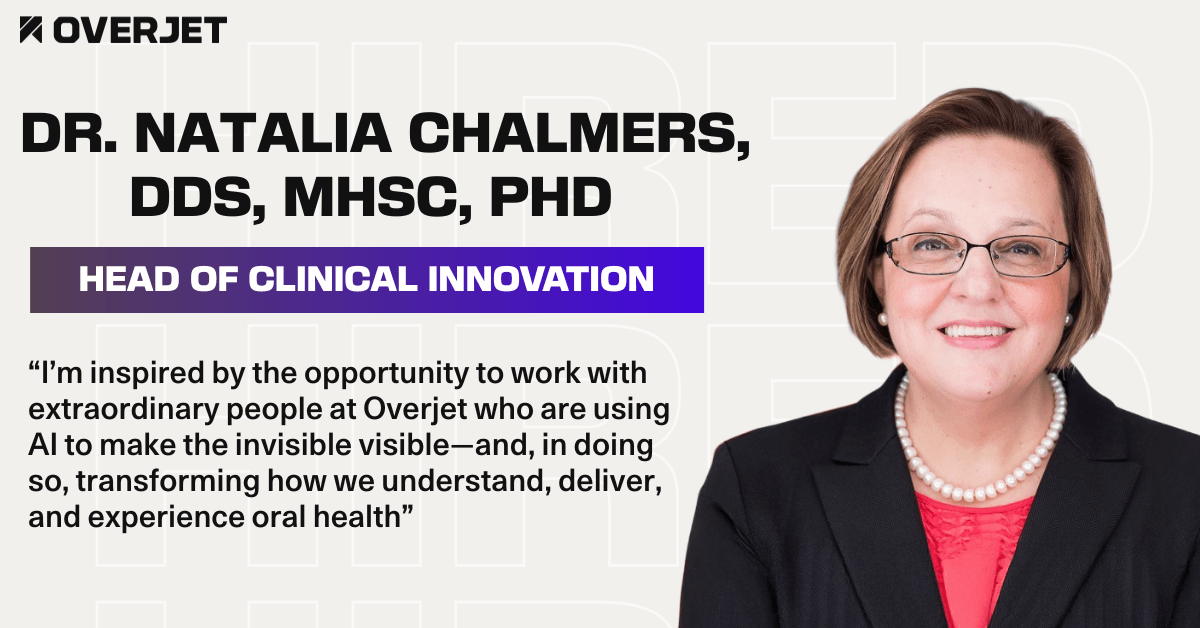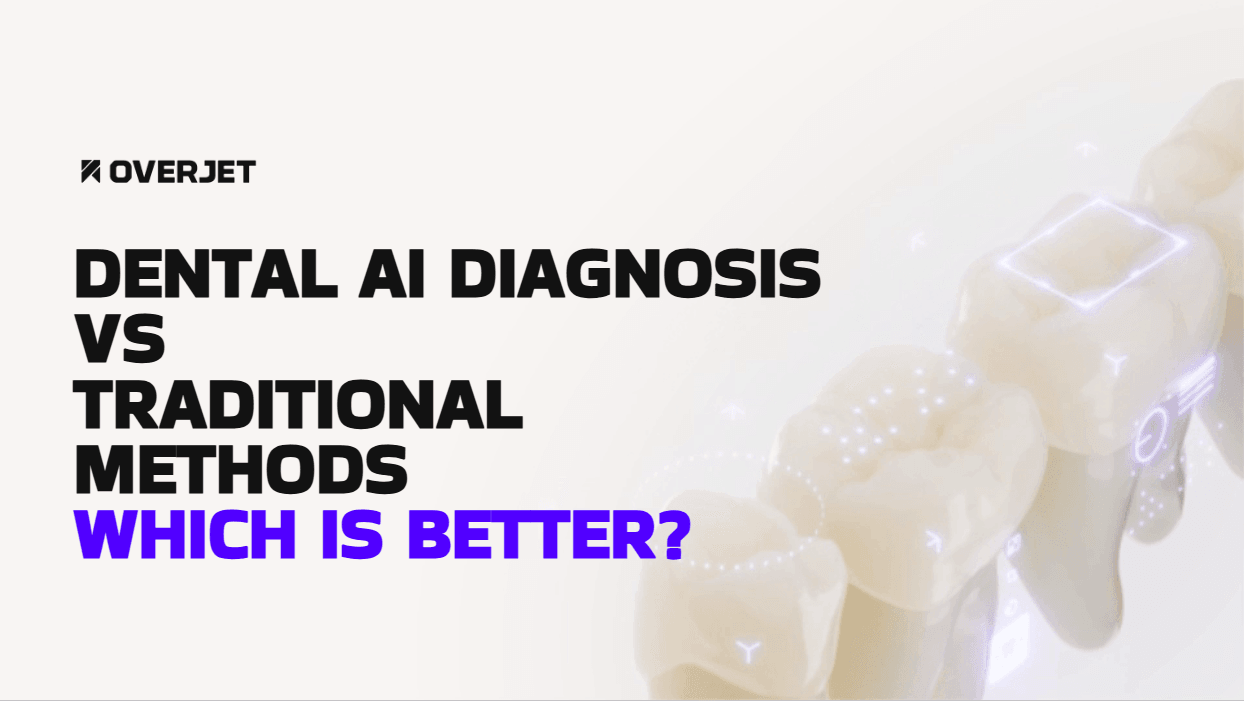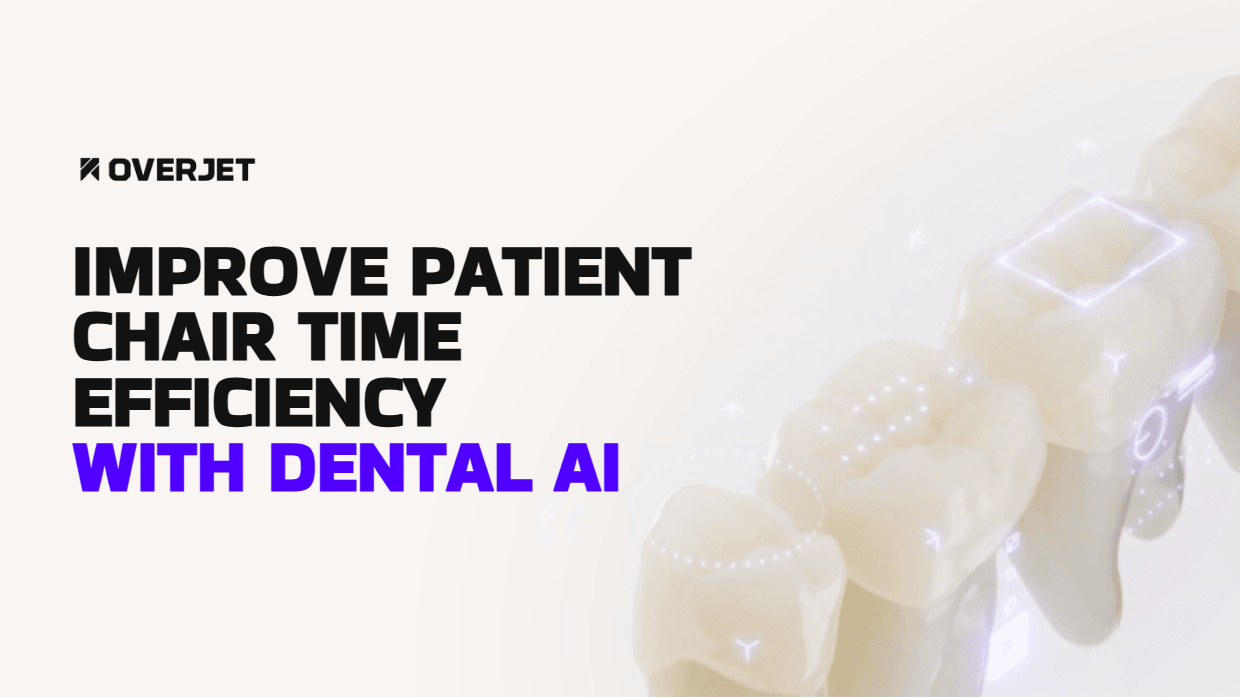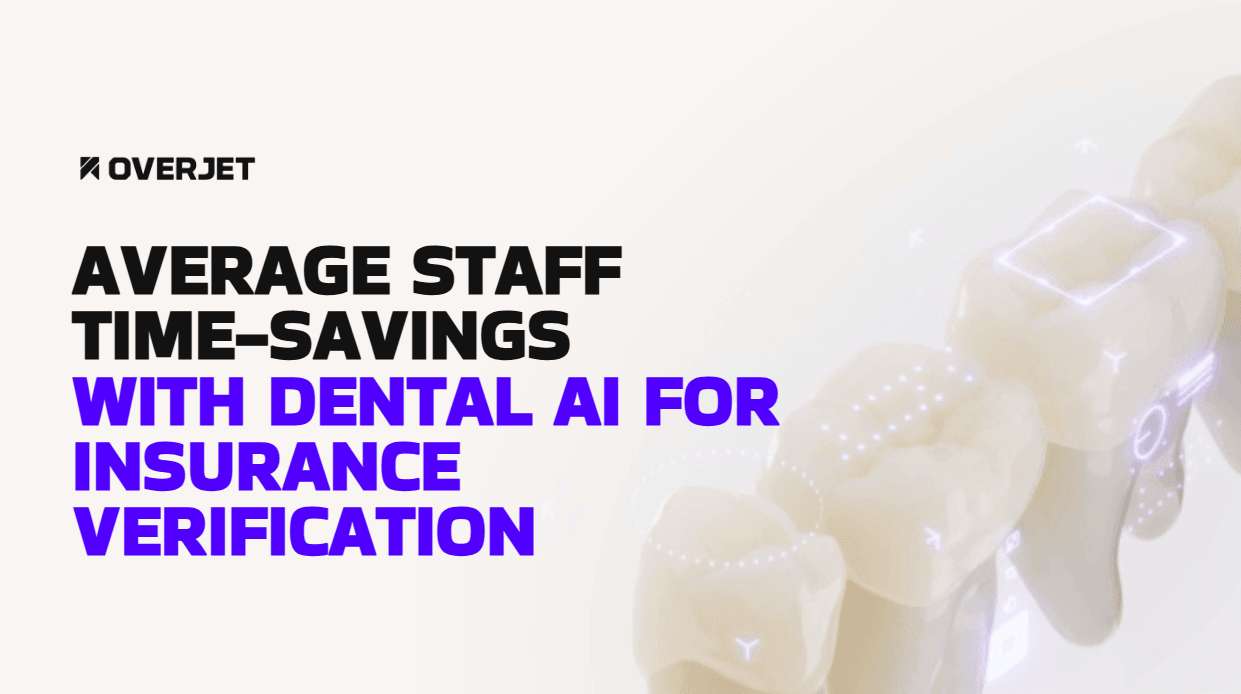Diagnostic oversights cost dental practices far more than the immediate treatment opportunity. They trigger a cascade of revenue losses through reduced case acceptance, patient attrition, claim denials, and wasted chair time on emergency visits that could have been prevented. A single missed interproximal caries might represent $200 in lost production today. However, the actual financial impact multiplies when that patient questions your clinical judgment, defers future treatment, or leaves for a competitor who caught what you didn’t.
This article examines how diagnostic errors directly affect practice profitability, identifies the common clinical and workflow factors that cause missed findings, and explores how AI-powered imaging analysis helps practices close diagnostic gaps while improving both patient outcomes and revenue performance.
Explore Overjet's Dental AI Software
Financial Toll of Diagnostic Errors on Dental Practices
Missed diagnoses create a direct line to lost revenue. When a provider overlooks interproximal caries or early bone loss, the practice loses the immediate opportunity to present treatment. Beyond that initial loss, the financial impact spreads. Patients become hesitant to accept costlier treatments once disease progresses, trust erodes when conditions worsen between visits, and some patients leave entirely for a second opinion that reveals what was missed.
The administrative side takes a hit too. Incomplete or inaccurate documentation leads to claim denials, which means delayed payments and staff time spent on resubmissions. This cycle affects cash flow and adds operational costs that don’t show up as line items but drain resources nonetheless.
Direct Lost Production From Undiagnosed Disease
Every undetected condition represents revenue walking out the door. When you miss a two-surface caries during a routine exam, you’ve lost a straightforward restorative procedure the patient would likely accept. The pattern repeats across different findings:
Undiagnosed periodontal disease means missed scaling and root planing appointments, potential surgical cases, and ongoing maintenance revenue
Overlooked cracked teeth translate to lost crown placements and endodontic procedures
Undetected bone loss means deferred implant consultations and prosthetic planning
The conditions don’t disappear. They either progress into complex cases or the patient seeks care elsewhere after symptoms develop.
Indirect Costs Including Chair Time Waste and Patient Attrition
Emergency appointments for problems that could have been caught earlier disrupt the schedule. You’re either compressing other patient visits or staying late. Additionally, retreatments for failed restorations placed without recognizing underlying pathology waste chair time and materials while damaging patient confidence.
Patient attrition carries the heaviest long-term cost. When someone discovers through a second opinion that their provider missed obvious pathology, they rarely return. That loss includes their lifetime value and any referrals they might have generated.
How Missed Findings Erode Case Acceptance and Production
Diagnostic accuracy forms the foundation of case presentation. When patients sense uncertainty in your diagnosis or remember previous visits where conditions weren’t mentioned, they question whether recommended treatments are actually necessary. That doubt kills case acceptance.
Patient Trust and Presentation Challenges
Clear diagnoses supported by visual evidence create conditions for successful case acceptance. However, presenting a treatment plan for a condition that wasn’t documented previously triggers skepticism. Patients wonder whether the problem is genuinely new or was overlooked previously, and that uncertainty undermines your clinical judgment.
Overjet’s AI-powered imaging analysis provides consistent, objective detection across patient encounters. The platform generates annotated radiographs that highlight pathology clearly, giving you visual tools to demonstrate findings in ways patients immediately grasp.
Deferred Treatment and Downstream Restorative Losses
Small problems caught early typically result in conservative, affordable treatments patients readily accept. The financial trajectory shifts dramatically when those same conditions progress undetected. Early interproximal caries means a single-surface composite restoration, while moderate caries reaching dentin requires a larger restoration with potential cuspal coverage. Advanced caries approaching the pulp demands a crown with possible endodontic therapy.
Each progression stage represents higher patient costs, which reduce acceptance likelihood, plus increased clinical complexity and chair time. The revenue per procedure may increase, but overall production suffers when patients decline treatment or look elsewhere.
Common Clinical and Workflow Causes of Missed Diagnoses
Most diagnostic oversights stem from predictable workflow challenges and human visual limitations rather than clinical incompetence. Recognizing why errors occur reveals opportunities for systematic improvement.
Inadequate Radiograph Interpretation
Human eyes struggle with subtle grayscale variations in dental radiographs, especially when viewing dozens of image sets daily. Interproximal caries in posterior teeth, incipient lesions beneath existing restorations, and early bone loss patterns frequently escape detection during routine screenings. Fatigue, time pressure, and cognitive biases further reduce interpretation accuracy as the day progresses.
Overjet’s FDA-cleared algorithms analyze radiographs with consistent precision, detecting caries, calculus, and bone loss patterns that human reviewers commonly miss. The technology functions as a second set of eyes, flagging potential pathology for provider review and reducing the cognitive load of image interpretation.
Time Pressure and Handoff Breakdowns
Compressed appointment schedules create conditions where thoroughness suffers. When hygienists conduct initial exams but providers perform final checks under time constraints, communication gaps emerge. A hygienist might note questionable areas verbally, yet if that information isn’t captured in the chart, the provider may not investigate further during their brief exam time.
Group practices and DSOs face additional handoff challenges when patients see different providers across visits. Without consistent diagnostic protocols and clear documentation standards, findings noted by one clinician might not receive appropriate follow-up from another.
Documentation Gaps
Incomplete charting creates both clinical and administrative problems. When you detect early pathology but delay documentation pending patient decision-making, that finding may never make it into the permanent record. Future providers lack awareness of the condition’s history, and insurance claims submitted later lack the timeline documentation that strengthens medical necessity arguments.
Poor documentation also complicates treatment planning conversations. Patients reviewing their records or seeking second opinions find incomplete information that raises questions about care quality.
Quantifying Revenue at Risk in Your Practice
Translating diagnostic accuracy into financial terms helps justify investments in improvement systems and technology. While exact figures vary by practice type and patient demographics, the calculation framework remains consistent.
Sample Formula for Per-Patient Production Loss
Consider your practice’s average restorative procedure value and typical case acceptance rate for different condition severities. A simple framework multiplies your estimated missed diagnosis rate by average treatment value, then factors in your acceptance rate differential between early-stage and advanced-stage presentations.
If your practice sees 40 patients daily and misses one significant finding per day, that represents roughly 250 missed diagnoses annually. Even if only 60% of those patients would have accepted treatment, you’re looking at 150 lost procedures, each representing your average restorative case value.
Benchmark Data From Multisite DSOs
Larger dental organizations tracking diagnostic consistency across providers typically observe significant variation in condition detection rates. Organizations implementing AI diagnostic support report detection rate improvements of 30–40% for common conditions like interproximal caries and calculus. Those gains translate directly to increased treatment opportunities and more predictable production across provider teams.
AI-Powered Radiograph Analysis to Close Diagnostic Gaps
Modern AI diagnostic platforms address the root causes of missed findings by providing objective, consistent image analysis at the point of care. The tools augment rather than replace clinical judgment, offering decision support that enhances diagnostic confidence.
FDA-Cleared Algorithms for Caries and Bone Loss
FDA clearance for medical AI devices signifies that the technology has undergone rigorous validation demonstrating safety and effectiveness for its intended use. Overjet’s platform holds FDA clearance for detecting and quantifying dental conditions including caries, calculus, and bone loss, ensuring the technology meets clinical standards for diagnostic support.
The algorithms analyze radiographic images in seconds, highlighting areas of concern with color-coded annotations that make pathology immediately visible. This visual enhancement helps both providers and patients see conditions that might otherwise require significant explanation.
Decision Support at Point of Care
Real-time diagnostic assistance changes the clinical workflow by providing immediate feedback during patient appointments. Rather than reviewing images later and potentially missing the opportunity for same-visit treatment discussion, providers receive AI analysis as soon as radiographs are captured.
Overjet integrates seamlessly with existing practice management systems and imaging software, requiring minimal workflow disruption. The platform’s annotations appear directly on the images you’re already viewing, creating a natural enhancement to your standard diagnostic process.
Implementation Roadmap for Integrating AI Diagnostics
Successfully adopting AI diagnostic technology requires thoughtful planning beyond simple software installation. Practices seeing the strongest results approach implementation as a systematic workflow improvement rather than just adding another tool.
Step 1: Select Evidence-Based AI Vendor
Clinical validation distinguishes legitimate diagnostic AI from marketing hype. Look for platforms with peer-reviewed research demonstrating accuracy, FDA clearance for specific clinical indications, and transparent performance metrics. The vendor’s integration capabilities with your existing technology stack matter significantly, seamless data flow prevents the tool from becoming a workflow bottleneck.
Consider the vendor’s track record with practices similar to yours. DSOs have different needs from single-location practices, and pediatric-focused providers require different capabilities from general practices emphasizing implant dentistry.
Step 2: Train Providers and Calibrate Protocols
Technology adoption succeeds when clinical teams understand both how to use the tools and why they matter. Initial training covers technical operation, but the more important learning involves interpreting AI findings within your clinical decision-making framework. The AI highlights potential pathology, but providers still determine appropriate treatment timing and approach based on patient-specific factors.
Establish clear protocols for how AI findings get documented, discussed with patients, and incorporated into treatment plans. Consistency across your team ensures patients receive uniform care quality regardless of which provider they see.
Step 3: Monitor Early Metrics and Iterate
Track key indicators from day one of implementation: diagnostic capture rates, same-day treatment acceptance, and claim approval rates. Early data reveals whether the technology is being used consistently and whether it’s delivering expected benefits. You might discover that certain providers embrace the tool more readily than others, suggesting additional training opportunities or workflow adjustments.
Most practices report that AI diagnostic tools feel natural within 2–3 weeks of consistent use, after which the enhanced detection becomes the new baseline.
Key Performance Indicators to Track Post-Implementation
Measuring the impact of improved diagnostic accuracy requires looking beyond simple production numbers to understand how detection improvements flow through your entire revenue cycle.
Diagnostic Capture Rate
This metric tracks what percentage of pathology present in your patient population you’re actually detecting and documenting. While you can’t know the true denominator without perfect information, you can measure increases in conditions documented per patient encounter after implementing AI support. Significant jumps in detection rates indicate the technology is identifying findings that were previously missed.
Higher capture rates directly correlate with increased treatment opportunities. When patients understand they have conditions requiring attention, supported by clear visual evidence, acceptance rates typically improve alongside detection improvements.
Same-Day Treatment Acceptance
Confident diagnoses supported by compelling visual evidence enable more patients to move forward with treatment immediately rather than deferring decisions. This metric measures what percentage of diagnosed conditions result in same-visit treatment acceptance or scheduling.
Same-day acceptance dramatically improves production efficiency by reducing the administrative overhead of follow-up calls and rescheduling while capturing revenue before patients have time to develop cold feet.
Claim Approval Velocity
The time between claim submission and payment reflects how convincingly you’ve documented medical necessity. Claims supported by AI-annotated radiographs that clearly show pathology typically move through adjudication faster than those relying on narrative descriptions alone.
Faster claim approval directly improves cash flow, reducing the capital you have tied up in accounts receivable and lowering the risk of aged claims becoming write-offs.
Hidden Revenue Cycle Ripple Effects With Insurers
The connection between diagnostic accuracy and insurance reimbursement extends beyond individual claim approval to affect your broader relationship with payers and your reputation within insurance networks.
Reduced Denials for Insufficient Evidence
Insurance companies deny claims when submitted documentation doesn’t adequately demonstrate treatment necessity. Overjet’s AI-generated annotations provide objective, visual evidence that clearly shows the conditions you’re treating, making it significantly harder for adjusters to question medical necessity. The platform’s quantitative measurements, such as bone loss percentages and lesion depth, add precision that strengthens your clinical justification.
Fewer denials mean less staff time spent on appeals and resubmissions, reducing administrative costs while accelerating revenue recognition.
Faster Adjudication and Cash Flow
Claims that move quickly through insurance review improve your practice’s financial health by reducing days in accounts receivable. When insurers receive claims with clear, AI-annotated images from Overjet, adjusters spend less time requesting additional documentation or questioning treatment appropriateness.
Improved cash flow provides working capital for practice investments, reduces reliance on credit lines, and creates financial stability that supports long-term growth planning.
Moving Toward Diagnostic Excellence and Sustainable Growth
Diagnostic accuracy represents a competitive advantage that compounds over time through patient retention, referral generation, and operational efficiency. Practices known for thorough, technology-enhanced care attract patients seeking comprehensive treatment and providers wanting to practice at the highest clinical standard.
The investment in AI diagnostic technology pays dividends across multiple dimensions: increased production from better detection, improved case acceptance from confident presentation, reduced administrative costs from cleaner claims, and enhanced patient trust from consistent, evidence-based care.
Ready to See Overjet's Dental AI in Action?
Frequently Asked Questions (FAQs)
What percentage of dental diagnoses are typically missed in general practice?
Diagnostic error rates vary significantly based on condition type and practice protocols. Modern AI diagnostic tools can help reduce error rates substantially by providing consistent, objective analysis across all patient encounters.
How quickly can AI diagnostic tools show return on investment for dental practices?
Most practices see improved case acceptance and reduced claim denials within the first few months of implementing AI diagnostic technology. The revenue benefits typically outweigh technology costs through increased treatment acceptance and operational efficiency.
Can AI diagnostic findings be submitted directly to insurance companies as claim evidence?
Yes, FDA-cleared AI diagnostic tools like Overjet generate annotated images and reports that insurers accept as supporting documentation for treatment claims. This enhanced evidence often leads to faster claim approvals and fewer denials.









